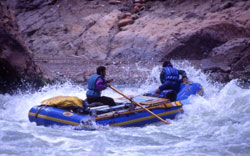|
|
RESOURCES
Resources: Annual Reports | Newsletters | Fact Sheets | Reports & Proposals | Links | Press Releases
Colorado River Management Plan
 This fact sheet supports protection of wilderness character and eventual wilderness designation in Grand Canyon National Park. In the case of a proposed wilderness such as the Colorado River corridor, NPS policy directs superintendents to “seek to remove” uses that do not conform to wilderness standards in their current management plans. This fact sheet supports protection of wilderness character and eventual wilderness designation in Grand Canyon National Park. In the case of a proposed wilderness such as the Colorado River corridor, NPS policy directs superintendents to “seek to remove” uses that do not conform to wilderness standards in their current management plans.
Why the Colorado River?
-
 The
Colorado River and Grand Canyon National Park are natural resources
of national and global significance, drawing tremendous revenue to
the state and dramatically increasing the quality of life for Arizonans.
-
The health of Grand Canyon National Park’s
river ecosystem has already been seriously degraded from operation
of Glen Canyon Dam upstream, which has caused loss of 95% of the river’s
sediment and nutrient base and an acute decline in native fish and
mammals that once thrived along the river.
-
The opportunity for experiencing wilderness serenity,
natural quiet, and seclusion on the Colorado River has been severely
diminished as a result of increased, crowded motorized boat trips—which
rush people down the river faster, with greater chances of encountering
non-motorized boating parties.
Problems and Actions Required
-
Current commercial boat trip sizes range between
30-42 passengers, clearly exceeding the 25-person limit supported
by earlier research and acknowledged by the Park Service’s original
river management plan. Trip size must be consistent with visitor expectations
in wilderness.
-
Today, current trip launches of 7 or more large
groups per day in the summer greatly exceed wilderness-based recommendations.
Launches must be limited and spread between spring, summer, and fall
seasons to alleviate crowding while still providing comparable access
to the American public.
-
The management plan should address alternatives
to helicopter transportation to and from the river, as it is inconsistent
with the intent of wilderness. These unnecessary flights also disturb
other backcountry users and destroy the preservation of natural quiet.
-
NPS has consistently endorsed wilderness for the
Colorado River. Motors are prohibited in wilderness and powerboats
are not necessary for safe public access to the river. These methods
of using the river must be phased out to halt further degradation
of wilderness integrity along the Colorado River.
 The
Arizona Wilderness Coalition urges members of Congress to resist attempts
by river concessionaires and other groups to halt the current Colorado
River Manage-ment Plan process and its inherent public involvement. We
ask that they reject potential wilderness legislation that leaves the
Colorado River outside of wilderness boundaries. Instead, we ask that
members support wilderness river alternatives that: The
Arizona Wilderness Coalition urges members of Congress to resist attempts
by river concessionaires and other groups to halt the current Colorado
River Manage-ment Plan process and its inherent public involvement. We
ask that they reject potential wilderness legislation that leaves the
Colorado River outside of wilderness boundaries. Instead, we ask that
members support wilderness river alternatives that:
- protect the river from further motorized noise and pollution
- alleviate river and launch crowding
- keep trip size to a limit consistent with wilderness expectations
- provide fair access to traditionally under-represented groups on the river.
All photos by Mark Miller
|

